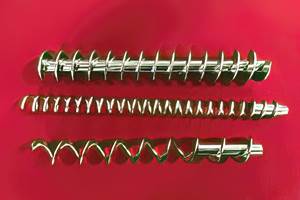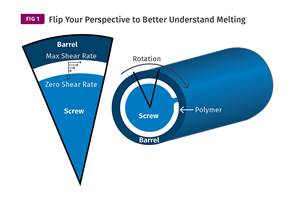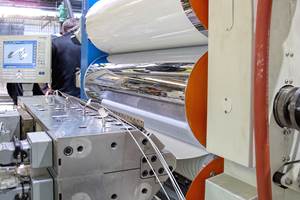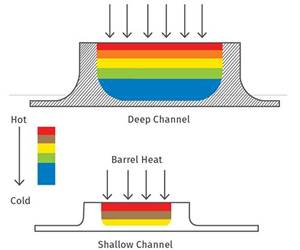How Compression Ratio Impacts Extruder Performance
Let’s investigate how compression ratio affects performance of an extruder processing LLDPE.
Single-screw extrusion at high rates and high qualities, and discharging at the proper temperature and pressure depends on numerous process features, including operational set points and the screw design.
Two very important screw design parameters are the metering channel depth and the compression ratio. If the compression ratio is too low, low rates and low specific rates can occur. If the ratio is too high, melting rate limitations and high screw wear can occur. In this article, we’ll show how the compression ratio affects the performance of the extruder for a linear low density polyethylene (LLDPE).
Solid polymer fragments are likely to be discharged from the extruder at high screw speeds because of the processes governing solids conveying, melting and the metering sections. For example, if the screw speed is doubled, the capacity for solids conveying and metering sections will also double. The melting flux, however, will only increase by a factor of about 1.4 times. The melting flux has units of kg/(hr m2) where the unit area term is the area near the barrel wall where melting is occurring. The melting capacity is defined as the melting flux × the melt film area adjacent to the barrel wall which is available for melting.
As the screw speed is increased — and because the melting flux does not increase at the same rate as solids conveying and metering — additional area at the barrel wall is needed for melting. Thus, the solid bed is forced downstream such that more area near the barrel wall will be used to melt the additional resin. Because of limited barrel surface area, eventually some solids will not be melted and will instead be discharged with the extrudate. Solid bed breakup is very common and decreases the melting capacity of the extruder and can contribute to solids in the discharge. Solid bed breakup is more likely to occur at high screw speeds when the solid bed enters the metering section. The most effective short-term solution to mitigate these fragments is to decrease the extrusion rate.
The melting and extruder performance depends on many screw design and process parameters. These include the metering channel depth, section lengths, lead length and compression ratio. For most screws, the compression ratio is simply the feed channel depth (Hf) divided by the metering channel depth (H). This simple ratio (Hf/H) assumes that the lead length in the feed and metering sections are the same.
The compression ratio specifies the feed channel depth needed to keep the metering channel full of resin and pressurized. The proper ratio depends on the bulk density and the solids conveying ability of the feedstock resin. For LLDPE pellet feedstocks, the optimal compression ratio is about 2.8. Here the bulk density of the feedstock is about 0.59 g/cm3. If a moderate level of film recycle is added to the pellets which causes the bulk density of the feedstock to decrease substantially, then a compression ratio of 2.8 might not be high enough to keep the metering channel full of resin and pressurized. Instead, the feed channel depth would need to be increased to compensate for the lower bulk density of the feedstock.
Case Study: Five Screws Compared
The performance of five screws with different compression ratios will be presented here for LLDPE using a highly instrumented, 2.5-inch diameter extruder. The screws only differed in the depth of the feed channel. The metering channel depths were the same at 0.125 inch, providing a specific rotational rate of 0.61 kg/(hr rpm). The specific rotational rate is historically known as the specific drag flow rate (the rate due to just the rotation of the screw without an imposed axial pressure gradient). The screws were labeled by their compression ratio. That is, the screw with a compression ratio of 2.8 was labeled CR2.8. A list of the screws is provided in the table below.

A schematic of the extruder and the die are shown in Figure 1. Extrudate logs were collected and sectioned perpendicular to the flow axis and examined for solid polymer fragments. Photographs of the cross sections are shown in Figure 2 as a function of compression ratio and screw speed. The feed resin was a blend of LLDPE pellets and a black masterbatch at a 100: 1 letdown ratio. Because the black colored masterbatch was only 1 part in 100 parts natural resin, statistically a solid fragment would be natural in color (translucent white). Resin that was discharged in a molten state would be mixed with the black pigment and tinted black.
FIG 1 Schematic of the extrusion log sampling process, and an axial cross section of an 11-mm diameter log. All images: L. Jin, M. Spalding
At low screw speeds of 30 to 70 rpm, the sample logs were well mixed and only a few very small white streaks were observed for all screws, indicating the extrusion process was operating within its melting capacity. For screw speeds of 90 to 130 rpm, some low levels of white streaks were observed for the screws with a compression ratio of 2.0 and 2.4. For screws with compression ratios of 2.8 and higher, and screw speeds of 110 rpm and higher, larger levels of solid polymer fragments were observed.
This occurred because the melting capacity was less than the rate of the extruder. At high rates, the solid bed is forced downstream, using more barrel area to melt the resin. When the solid bed approaches the end of the barrel, the melting capacity is exceeded and solid polymer fragments are discharged from the extruder. Moreover, solid bed breakup is more likely to happen at high screw speeds, contributing to discharged fragments.
At screw speeds of 90 rpm and higher, the level of solid fragments depended on the compression ratio of the screw and screw speed. For example, for the CR2.0 screw, the cross sections at all screw speeds were well mixed with very few white streaks. As the compression ratio increased for screw speeds of 90 rpm and higher, the level of solid polymer fragments increased.

FIG 2 Schematic of the log cross sections as a function of compression ratio and screw speed
The cross sections shown in Figure 2, however, only show the level of solids at a moment in time. The level of solids in the discharge, however, varied with time. Once more, the melting flux and thus the melting capacity depend on pressure, temperature and velocity between the solid bed and the barrel wall. As the compression ratio increased, the feed channel became deeper and the solids conveying capacity increased. Once the rate exceeded the melting capacity, solid polymer fragments appeared in the discharge, creating defects in the final product.
Screws with compression ratios near 2.8 are preferred for commercial extrusion of LLDPE pellet feedstocks to produce film and sheet.
The specific rate as a function of compression ratio and screw speed is shown by Figure 3. The specific rate is simply the rate divided by screw speed. Furthermore, the calculated specific rotational rate of 0.61 kg/(hr rpm) is also displayed. The specific rate for the CR2.0 and CR2.4 screws at 30 rpm were 17% and 7% less than the specific rotational rate, respectively.
FIG 3 Specific rates as a function of compression ratio and screw speed.
For these screws, the low compression ratios limited the ability of the screws to develop pressure in the downstream direction. That is, the feed section was not deep enough to maintain the metering section completely full of resin and pressurized. At higher screw speeds, the specific rate increased to 11% higher than the specific rotational rate for the CR2.0 screw and to 30% higher than the specific rotation rate for the CR2.4 screw. For the CR2.8 screw, the specific rate was the highest among all the screws and was 28 to 37% higher than the specific rotational rate.
For a commercial process, an optimal screw for most LLDPE pellet resins will have a compression ratio of 2.8. The specific rates for the CR3.2 and CR3.6 screws were lower but still in the similar range as that for the CR2.8 screw. Overall, larger compression ratio screws with deeper feeding sections can have higher solids conveying capacities.
The axial pressure profile for the extrusion process at 70 rpm as a function of compression ratio is shown in Figure 4. A screw speed of 70 rpm was selected as it is in the range normally used for commercial processes, such as blown film.
FIG 4 Axial pressure profile at a screw speed of 70 rpm as a function of compression ratio.
In general, the channel pressures increased with increasing compression ratio. For the extrusion process with the CR2.0 screw, the pressure at diameter 9 was only around 100 psi and the highest pressure developed was 2,500 psi at diameter 16. This indicates the screw had limited ability to develop pressure. The other screws showed the highest axial pressures in the range of 4,200 to 5,800 psi at diameter 13, which is near the end of the transition section.
For all screws, a trend of negative axial pressure gradients in the metering sections was observed. The axial pressure gradients in the metering section were essentially identical for the CR2.4, CR2.8, CR3.2, and CR3.6 screws, consistent with the nearly identical specific rates shown by Figure 3. Moreover, the negative axial pressure gradients indicate that specific rates would be higher than the calculated specific rate due to just rotation, consistent with Figure 3.
The axial pressure profile for the extrusion process at 30 rpm as a function of compression ratio is shown by Figure 5. A screw speed of 30 rpm was selected because the specific rates for the screws at this low screw speed were significantly different than those shown by Figure 4 at 70 rpm.
FIG 5 Axial pressure profile at a screw speed of 30 rpm as a function of compression ratio.
For the extrusion processes with the CR2.0 and CR2.4 screws, the pressure started at zero and became positive at diameters 18 and 13, respectively. The highest pressure developed was 600 psi at the end of the screws. All the other screws showed the highest axial pressures in the range of 3,200 to 4,000 psi at diameter 13, which was consistent with the trend for those screws at 70 rpm. For the CR2.0 screw, the axial pressure gradient near the exit was positive, consistent with the specific rate being less than the specific rotational rate shown by Figure 3. The compression ratio was not high enough to maintain high pressures in the metering sections for the CR2.0 and CR2.4 screws at a screw speed of 30 rpm.
The discharge temperatures for the extrusions are shown in Figure 6. They were measured using a handheld thermocouple in the discharge stream. Because the thermal conductivity of the metal in the transfer line and thermocouple sheath are 200 times higher than that for the molten resin, thermocouples positioned in transfer lines are highly influenced by the temperature of the transfer line and can provide measurement errors. This topic was discussed in the December 2024 issue of this magazine. Handheld measurements are considerably more reliable.
FIG 6 Discharge temperature as a function of compression ratio and screw speed.
The discharge temperature for all screws increased with increasing screw speed as expected. This is consistent with larger energy dissipations under higher shear rates with increasing screw speeds. In addition, the discharge temperatures from screws with higher compression ratios (CR3.2, and CR3.6) were 5 to 10°C higher than those from screws of lower compression ratios (CR2.0, CR2.4, and CR2.8) at 110 to 150 rpm. This is related to high levels of dissipated energy caused by the higher pressures at the end of the transition section.
The axial pressure data clearly shows that at least a compression ratio of 2.4 is required for LLDPE pellet extrusion. For these screws, the pressure was high at the entry to metering section and the specific rates were nearly the same and higher than the specific rotational rate, except for a screw speed of 30 rpm. This was expected based on the negative axial pressure gradient in the metering channel. The screw with a compression ratio of 2.0 could not convey enough solids, causing relatively low channel pressures at the entry to the metering section and low specific rates, especially at a screw speed of 30 rpm. Screws with compression ratios near 2.8 are preferred for commercial extrusion of LLDPE pellet feedstocks to produce film and sheet. Screws with compression ratios higher than 2.8 can cause high flight wear rates at the end of the transition section.
About the Authors: Lin Jin is a research scientist in Packaging & Specialty Plastics and Hydrocarbons R&D at Dow Inc. in Lake Jackson, Texas. During her 4-plus years at Dow, she has focused on troubleshooting of polymer processes in single-screw extrusion and reactive extrusion. Contact: 979-238-0915; ljin8@dow.com; .
Mark A. Spalding is a fellow in Packaging & Specialty Plastics and Hydrocarbons R&D at Dow Inc. in Midland, Michigan. During his 39 years at Dow, he has focused on development, design and troubleshooting of polymer processes, especially in single-screw extrusion. He co-authored with Gregory Campbell. Contact: 989-636-9849; maspalding@dow.com; .
Related Content
What to Know About Your Materials When Choosing a Feeder
Feeder performance is crucial to operating extrusion and compounding lines. And consistent, reliable feeding depends in large part on selecting a feeder compatible with the materials and additives you intend to process. Follow these tips to analyze your feeder requirements.
Read MoreUnderstanding Melting in Single-Screw Extruders
You can better visualize the melting process by “flipping” the observation point so the barrel appears to be turning clockwise around a stationary screw.
Read MoreRoll Cooling: Understand the Three Heat-Transfer Processes
Designing cooling rolls is complex, tedious and requires a lot of inputs. Getting it wrong may have a dramatic impact on productivity.
Read MoreThe Importance of Barrel Heat and Melt Temperature
Barrel temperature may impact melting in the case of very small extruders running very slowly. Otherwise, melting is mainly the result of shear heating of the polymer.
Read MoreRead Next
Making the Circular Economy a Reality
Driven by brand owner demands and new worldwide legislation, the entire supply chain is working toward the shift to circularity, with some evidence the circular economy has already begun.
Read MorePeople 4.0 – How to Get Buy-In from Your Staff for Industry 4.0 Systems
Implementing a production monitoring system as the foundation of a ‘smart factory’ is about integrating people with new technology as much as it is about integrating machines and computers. Here are tips from a company that has gone through the process.
Read MoreLead the Conversation, Change the Conversation
Coverage of single-use plastics can be both misleading and demoralizing. Here are 10 tips for changing the perception of the plastics industry at your company and in your community.
Read More











